Westside Toastmasters is located in West Los Angeles and Santa Monica, California
Chapter 4
WHAT ARM GESTURES CONVEY
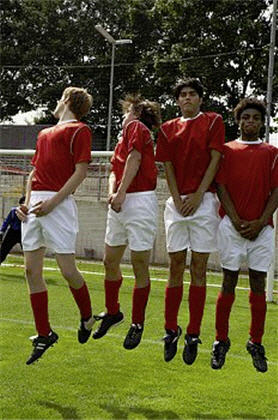
Holding their hands over their genitals makes men feel safer when threatened
Whether you're crossing your arms as a protective shield or opening them as a sign of welcome, the way you position your arms tells an insightful observer how you're feeling.
Certain postures elicit certain moods. Crossed arms hold your feelings in and keep other people's out. They show that you've set up roadblocks beyond which no person dares travel. Stay with this position for too long and you find yourself feeling shut off and negative. Unless, of course, you're cold, in which case holding your arms across your chest keeping the warmth in and the cold out makes perfect sense.
As for contact, touching can be a great restorative as long as you know who, when, where, and how to do it. Get touching right and the person you touch feels engaged and connected; get it wrong and prepare yourself for a dressing down. Here we show you how you can read arms signals, appear self-controlled, and increase your influence through physical contact.
Arm Barrier Signals
Hiding behind a barrier is a normal response we learn at an early age to protect ourselves. As children, we hid behind solid objects such as tables, chairs, furniture and mother's skirt whenever we found ourselves in a threatening situation. As we grew older, this hiding behavior became more sophisticated and by the age of about six, when it was unacceptable behavior to hide behind solid objects, we learned to fold our arms tightly across our chests whenever a threatening situation arose.
The arms crossed gesture can evolve and develop more nuanced forms during our adult years to become less obvious to others. By folding one or both arms across the chest, a barrier is formed that is an unconscious attempt to block out what we perceive as a threat or undesirable circumstances. The arms fold neatly across the heart and lungs regions to protect these vital organs from being injured, so it's likely that arm-crossing is inborn.
Monkeys and chimps also do it to protect themselves from a frontal attack. One thing's certain: when a person has a nervous, negative or defensive attitude, it's very likely he will fold his arms firmly on his chest, showing that he feels threatened.
The Downside of Crossed Arms
Research conducted into the arms crossed gesture showed interesting results. A group of volunteers was asked to attend a series of lectures and each student was instructed to keep his legs uncrossed, arms unfolded and to take a casual, relaxed sitting position. At the end of the lectures each student was tested on his retention and knowledge of the subject matter and his attitude towards the lecturer was tracked. A second group of volunteers was put through the same process, but these volunteers were instructed to keep their arms tightly folded across their chests throughout the lectures. The results showed that the group with the folded arms had learned and retained 40% less than the group who kept its arms unfolded. The second group also had a more critical opinion of the lectures with reduced perceived credibility of the lecturer.
This type of test was conducted years ago with 1500 seminar attendees during a number of different lectures and produced almost identical results. These tests revealed that, when a listener folds his arms, not only does he have more negative thoughts about the speaker, but he is also paying less attention to what is being said. It is for this reason that training centers should have chairs with armrests to allow the attendees to leave their arms uncrossed.
I'm Just ... 'Comfortable'
Some people claim that they habitually cross their arms because it's comfortable. Any gesture will feel comfortable when you have the corresponding attitude; that is, if you have a negative, defensive or nervous attitude, folded arms will feel comfortable. If you're having fun with your friends, folded arms will feel wrong.
Remember that with all body language, the meaning of the message is also in the receiver, as well as the sender. You may feel 'comfortable' with your arms crossed and your back and neck stiffened, but studies have shown that others' reactions to these gestures is negative. So the lesson here is clear - avoid crossing your arms under any circumstances unless your intention is to show others you don't agree or don't want to participate.
Gender Differences
Men's arms rotate slightly inwards while women's arms rotate slightly outwards. These rotation differences have enabled men to aim and throw more accurately, while women's splayed elbows give them a wider, more stable position for carrying babies. One interesting difference is that women tend to keep their arms more open when they are around men they find attractive and are likely to fold their arms across their breasts around aggressive or unattractive men.
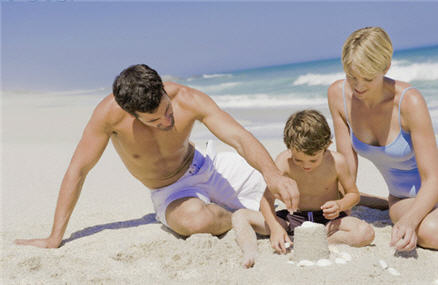

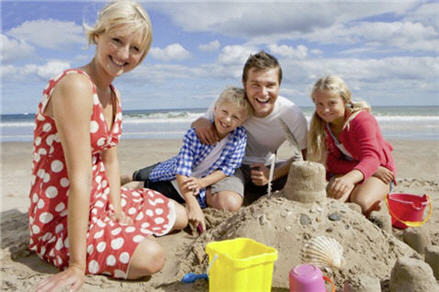
Inward rotating arms allow men to throw accurately; women's outward rotating arms make for better carrying
Arms Crossed On Chest
Both arms are folded together across the chest as an attempt to put a barrier between the person and someone or something they don't like. There are many arm-folding positions and we'll discuss here the most common ones you're likely to see. The arms crossed on chest gesture is universal and is decoded with the same defensive or negative meaning almost everywhere. It is commonly seen among strangers in public meetings, in queues or restaurant lines, elevators or anywhere that people feel uncertain or insecure.
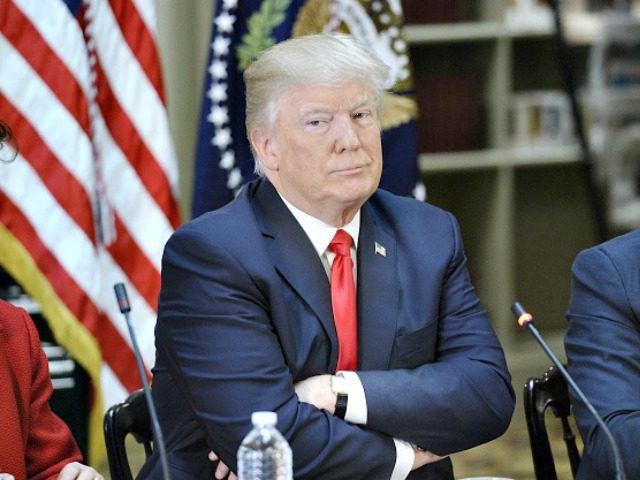
President Trump is not venturing out and you're not coming in
Most people will take an arms-folded position when they disagree with what they're hearing from another person speaking. Speakers will fail to communicate their message to their audience if they have not picked up on the crossed-arms position of their listeners. Experienced speakers know that this gesture means a good 'ice breaker' is needed to move their audience into a more receptive position that will change their attitude from negative to positive.
When you see someone take the crossed arms posture, it's reasonable to assume that you may have said something with which they disagree. It may be pointless continuing your line of argument even though the person could be verbally agreeing with you. The fact is that body language is more honest than words.
Your objective should be to try to work out why they crossed their arms and to try to move the person into a more receptive position. The attitude causes the gesture to occur and maintaining the gesture forces the attitude to remain.
A simple effective way of breaking the arms-folded position is to give the listener something to hold or give them something to do. Giving them a pen, brochure, or refreshment forces them to unfold their arms and lean forward. This moves them into a more open position and, therefore, a more open attitude. Asking someone to lean forward to look at a visual presentation can also be an effective means of opening the arms-folded position. You could also lean forward with your palms up and say, 'I can see you have a question...what would you like to know?' or, 'What's your opinion?' You then sit or lean back to indicate that it's their turn to speak. By using your palms you non-verbally tell them that you would like them to be open and honest because that's what you're being.
Salespeople and negotiators are often taught that it's usually safer not to proceed with the presentation of a product or idea until the prospect's reason for folding his arms is uncovered. More often than not, buyers have hidden objections that most salespeople never discover because they missed seeing the buyer's arms-folded cluster, signalling that he was feeling negative about something.
A person with clenched fists as well as their arms crossed suggests hostility as well as defensiveness. If it's combined with a tight-lipped smile or clenched teeth and red face, a verbal or even physical attack could happen. A conciliatory approach is needed to discover what is causing it if the reason is not already apparent.
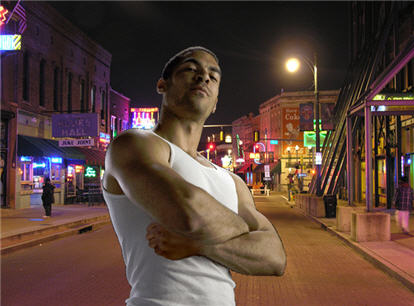
Arms crossed with fists clenched; hostility present?
Arm-Gripping
The double arm grip is characterized by the person's hands tightly gripping their upper arms to reinforce themselves and avoid exposure of the front of the body. Sometimes the arms can be gripped so tight that the fingers and knuckles can turn white as blood circulation is cut off. It's a person's way of comforting himself with a form of self-hugging. Arm-gripping is commonly seen in doctors' and dentists' waiting rooms or with first-time air travellers who are waiting for lift-off. It shows a negative, restrained attitude.

Feeling insecure and not buying what you're saying
Managers And Subordinates
Status can influence arm folding gestures. Someone higher in formal status or informal social status can make his preeminence felt by not folding his arms, saying, in effect, 'I'm in control'. Let's say that at a company social function, a manager is introduced to several new employees. After greeting them with a palm down handshake, he stands back to establish typical personal spacing after new introductions in a business setting, with his hands by his side, or perhaps behind his back. or with one or both hands in his pocket (non-involvement). He rarely folds his arms across his chest so as not to show the slightest hint of nervousness.
Conversely, after shaking hands with an executive, new employees may take on full or partial arms crossed positions due to apprehension about being in the presence of the company's top person. Both the manager and the new employees feel comfortable with their respective gesture clusters as each is signalling his relative status. What happens when a manager meets a young, confident, up and coming employee who senses and may even signal that he is equally as important as the manager? The possible outcome is that, after the two give each other a dominant handshake, the younger executive may take an arms folded gesture with both thumbs pointing upwards.
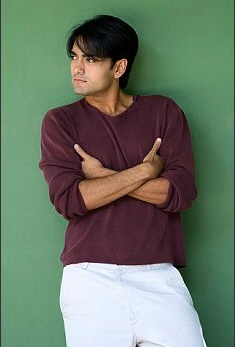
Defensive, but he still thinks he's cool
This gesture has the arms-crossed plus both thumbs up showing that he's feeling 'cool' and in control. As he talks, he gestures with his thumbs to emphasize points he is making, As we've already discussed, the thumbs-up gesture is a way of showing others we have a self-confident attitude and the folded arms still gives a feeling of protection.
Someone who is feeling defensive but also submissive at the same time will sit in a symmetrical position, which means one side of their body is a perfect mirror of the other. They display tense muscle tone and look as if they expect to be attacked whereas a person who is feeling defensive and dominant wil take an asymmetrical pose, that is, one side of the body doesn't mirror the other.
Getting the Thumbs-Up Signal
When you're presenting your case to someone and the arms crossed with thumbs up posture appears towards the end of your presentation and is clustered with other positive gestures, it signals you can move comfortably into asking the person for a commitment. On the other hand, if at the close of the presentation the other person takes the arms crossed with fists clenched position and has a poker face, you can be inviting trouble by attempting to get a 'yes'. It would be better to ask questions to try to uncover the person's objections. When someone says 'no' to a proposal, it can become difficult to change their mind without looking as if you're aggressive. The ability to read body language allows you to 'see' a negative decision before it is verbalized and gives you time to take an alternative course of action.
Historically, people carrying weapons or wearing armor seldom use arm gestures because their weapon or armor provides sufficient body protection. Police officers wearing guns infrequently cross their arms as they too feel instinctively protected.
Half Hugs
When we were children our parents or carers embraced or hugged us when we faced distressing or tense circumstances. As adults, we often attempt to recreate those same comforting feelings when we find ourselves in stressful situations. Instead of a full crossed arm gesture, suggesting anxiety or fearfulfulness, women often substitute a more understated half-hug posture with one arm across the body to hold or touch the other arm to create the barrier. Single arm barriers are often seen in meetings where a person may be a newcomer to the group or is light in self-confidence. Women taking this position in strained situations will often claim this is simply 'comfortable'.

Holding herself like her mother held her when she was a child
The Fig Leaf - Clasping Hands Over The Lower Abdomen
When a person finds themselves in a position where they feel vulnerable but are required to display confidence and respect, they may clasp their hands over their lower abdomen or crotch. This gesture is commonly observed when leaders and politicians or others in the public eye meet and stand to pose for photographs and videos. You might also see this gesture at social meetings presided over by an authoritative figure such as a priest delivering a sermon.
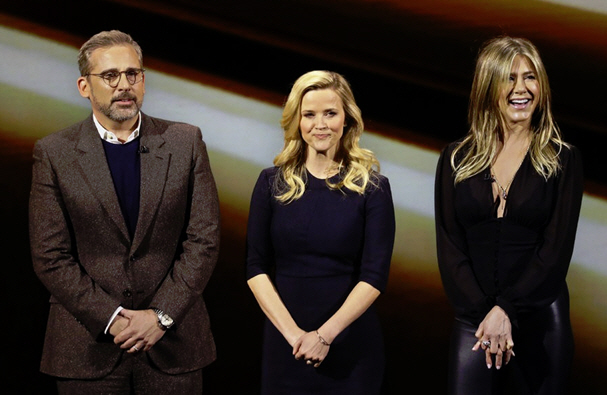
Trying to display confidence
Men hold their hands in this barrier-style position called the fig leaf to make themselves feel more secure by covering their 'crown jewels'. They subconsciously are protecting themselves from a potential physical full frontal attack. Don’t be fooled into thinking that this is a naturally confident position. The reason the position’s comfortable is because it acts like a shield. Look at the line-up of soccer players during a penalty kick and see where they place their hands and arms.
It's the same position people take in a line to receive unemployment benefits or to receive food at homeless shelters and reveals their vulnerable feelings. Adolf Hitler regularly exhibited this in public to mask the sexual inadequacy he felt because of having only one testicle.
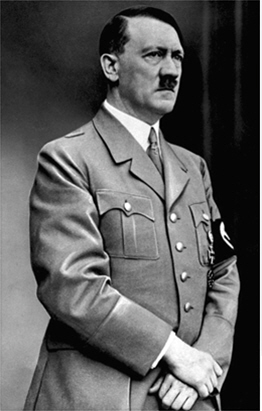
The fig leaf position
Evolution may have shortened men's arms to afford them the opportunity to take this protective position; chimpanzees, our closest primate cousins also assume this very same position except that their hands cross at their knees.
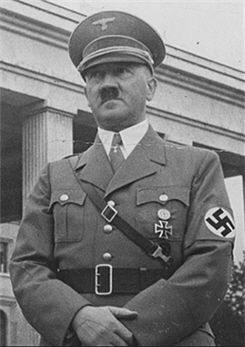

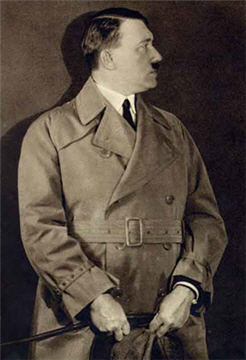
Humans protect areas they think are their weakest or most vulnerable
How Those With High Profiles Divulge Insecurities
People who are continually exposed to others, such as royalty, politicians, and entertainment media personalities, usually don't want their audiences to detect that they are nervous or unsure of themselves. They prefer to project a cool, calm, controlled attitude when on display, but their anxiety or apprehension leaks out in disguised forms of arm-crossing. As in all arm-cross gestures, one arm swings across in front of the body towards the other arm but instead of the arms crossing, one hand touches or holds on to a handbag, bracelet, watch,' shirt cuff or object on or near their other arm. Once again the barrier is formed and the secure feeling is achieved.
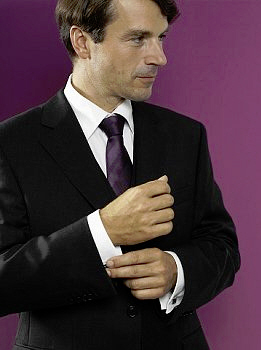
Famous people are just as nervous in public as the rest of us
Men wearing cufflinks are often seen adjusting them as they cross a room or dance floor where they are in full view of others.

Will Ferrell's cuff adjustment. Could THIS guy be revealing his insecurities?
An anxious or self-conscious man will also be seen adjusting the band on his watch, checking the contents of his wallet or rubbing his hands together, playing with a button on his cuff or using any gesture that lets his arms cross in front of his body. A favorite of insecure businessmen is walking into a business meeting holding a briefcase or laptop in front of the body. To the trained observer, these gestures are a giveaway because they achieve no real purpose except as an attempt to disguise nervousness. A good place to observe these gestures is anywhere that people walk past a group of onlookers, such as a man who crosses the dance floor to ask a woman to dance or someone who crosses a stage to receive an award.
Women's use of disguised arm barriers is less noticeable than men's because women can grasp onto things like handbags or purses if they become self-conscious or unsure of themselves.

Handbag used to form a barrier
Using Objects As Protective Barriers
By placing a coffee cup, a laptop, or any other object between yourself and another person, you are setting up a protective barrier. These barriers are a subconscious effort to conceal any nervousness or insecurity you may be experiencing, whether you're aware of the feeling or not.
If you're at a function where drinks are being served and you're feeling insecure, hold your glass or cup in front of you with both hands. This action creates a subtle barrier, behind which you can seek refuge. As you look around the room you are likely to see that almost everyone else is standing in the same position, indicating that you're not alone in your feelings.

Flower grasping shows self-consciousness
The Coffee Cup Barrier
Offering a refreshment during a negotiation is an excellent strategy for gauging how the other person is receiving your offer. Where a person places their cup immediately after they take a drink is a strong indicator of whether or not they are convinced or open to what you are saying. Someone who is feeling hesitant, unsure or negative about what they are hearing will place their cup to the opposite side of their body to form the equivalent of a single arm barrier. When they are accepting of what they are hearing they place the cup to the side of their body showing an open or accepting attitude.
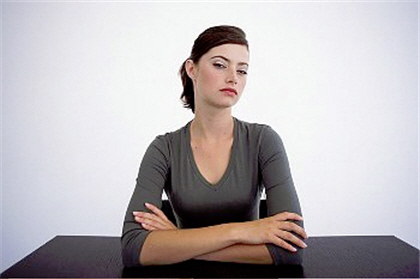
The arm barrier says 'no'

This posture is welcoming and open to your ideas
Conveying Amiability
Open arms indicate a receptive, friendly, and honest attitude. This position says that you've got nothing to hide and are approachable and amenable. It draws people to you, making them feel comfortable and at ease in your company. By leaving your body exposed you're indicating that you're receptive to whatever comes your way.
Go to any sporting event and watch the players. The moment the winner sinks his final putt, crosses the finish line, or scores the winning goal his arms open with the thrill of victory. The losers cross their arms in front of their bodies or let them hang dejectedly by their sides.
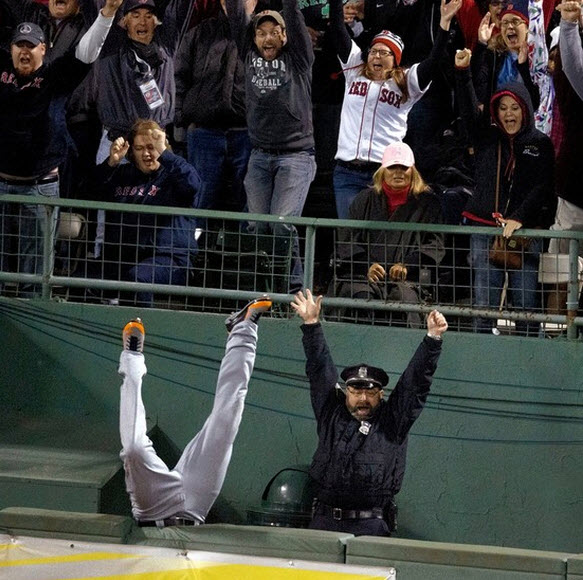
Commitment to victory
If you want to persuade someone to your viewpoint, hold your arms in an open position. Open arms indicate a confident, constructive attitude and create a positive impression. You're perceived as sincere, direct, and trustworthy, as long as your other gestures are equally open and forthright.
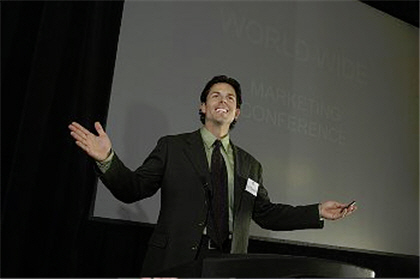
'Trust me'
Embracing While Coming And Going
The next time you're at an airport, watch how friends and family members hug when they're arriving and when they're departing. What you notice is that when people hug upon arrival they maintain the embrace longer than upon departure. When they first see one another, the hug is intense and the embrace strong. The people are welcoming and bringing one another into their most personal space. The departure hug is shorter and less passionate. It's almost as though by the time the people are saying good-bye they're having to let each other go.
If someone pats you on the back when you're hugging him, he's giving you a signal that 'enough is enough' and he's ready to be let go of.
Summary
It makes no difference how you look at it, any crossing of the arms in front of the body is seen as negative and the message is as much in the mind of the receiver as the sender. Even if you fold your arms because, for example, you have a backache, an observer will still unconsciously perceive you as closed to their ideas. Make a decision now to practice not crossing your arms and in the following sections there are recommendations for projecting a more positive, confident image.



